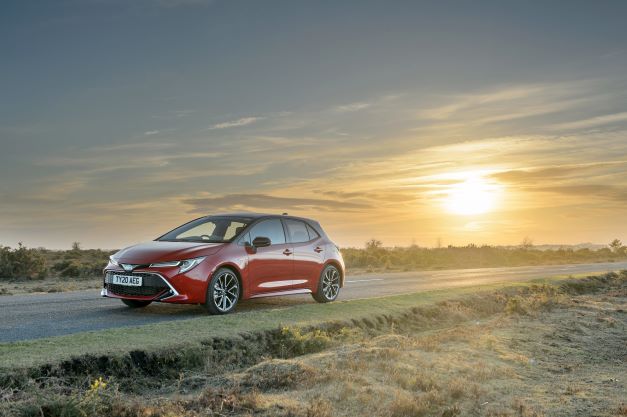
Predating the VW Golf, the 12th generation Toyota Corolla ranks as a top-seller in the hotly fought European C-segment. Today, three Corolla body styles are offered: Hatchback, Touring Sports and Saloon. Toyota Manufacturing UK’s (TMUK) Burnaston factory in Derbyshire is the European centre for the production of the Hatchback and Touring Sports, with hybrid engines (1.8-litre) supplied by the TMUK factory in Deeside, North Wales. Saloon models are produced by Toyota Motor Manufacturing Turkey.
Inside story
In terms of the main changes that Toyota made to the interior of the latest incarnation, Rembert Serrus, senior manager, vehicle performance, Toyota Motor Europe, said: “With the GA-C platform, the base of the windscreen was lowered by 40mm and the overall height of the dashboard was reduced to create a more elegant and lighter shape than before. On the materials and finishes side, we mapped the interior to ensure a consistent approach in all applications and, from the first 3D model, shapes were optimised in detail to ensure they looked authentic; for example, metal inserts look and feel like metal.”
It is certainly true that the interior touchpoints feel soft and plush. And in respect of measures taken to improve the car’s noise and vibration performance, Serrus added: “Overall cockpit sealing performance has been improved by using a much more effective dashboard silencer with a far smaller exposed area. There is also new door sealing, wheelhouse silencers at the rear, front acoustic glass and so on.”
Compared to its predecessor, the sculpted dash is slightly slimmer. The reduction in height of the upper panel area reduces the structure’s perceived mass and improves the driver’s forward view while enabling the front seat hip point to be lowered. The net result is a more engaging driving position.
The seven-inch instrument cluster includes the choice of a digital or analogue speedometer. The steering wheel integrates a new heating and optimised switch layout.
Positioned high centre stage of the dash is Toyota’s Touch 2 multimedia system, an eight-inch touchscreen that controls various infotainment features including a sat-nav system.
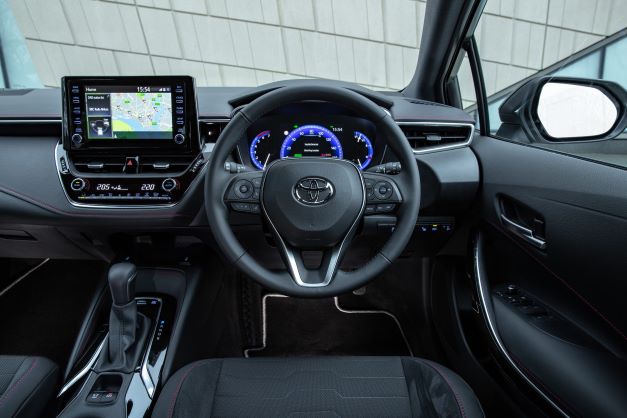
All versions of Corolla are fitted with eCall, a system that can automatically contact the emergency services in the event of an accident. Talking of connectivity, several services are in the process of being rolled out following the car’s launch, including Last Mile Guidance, Send to Car Navigation, Driving Analytics and Maintenance Reminder.
In the seating department, the revised front seat design features changes to the seatback and cushion springs and optimisation of the urethane pad thickness.
New sports front seats featured on Hatchback and Touring Sports Excel models have slim and wide shoulder supports that overlap thick side bolsters. The long wheelbase of the Touring Sports and Saloon has allowed for the front-to-rear couple distance to be increased by 48mm to 928mm, thereby improving rear-seat legroom.
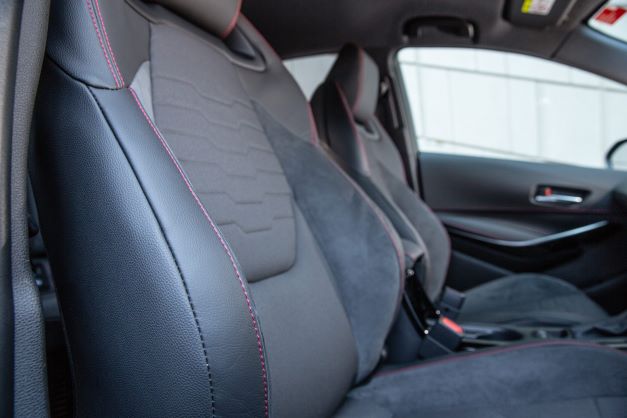
Further back, the boot provides 313-litres of storage capacity in the Hatchback version and 581-litres in the Touring Sports. Repositioning the rear shock absorbers has simplified the deck sidewall structure, maximising the loadspace width, facilitating loading and allowing side wall storage pockets to be added behind the rear wheel housings.
The load surface has a two-position (upper and lower) deck. This can be opened and closed in the upper position as if it were hinged from the rear seatbacks. It is also reversible, with carpet on one side and a resin finish on the other, suitable for use when carrying wet or dirty items.
The space beneath the deck has been made larger, carpeted and fitted with detachable side separators. There’s more convenience thanks to the LED load compartment lamps, a claimed world first, on either side of the boot and a detachable, retractable tonneau cover.
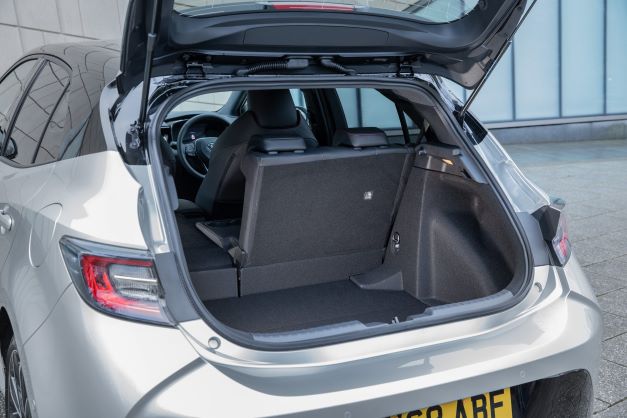
Other comfort and convenience features include a powered liftgate with kick sensor (Touring Sports only) and an always useful head-up display (optional).
Audio-wise, certain versions of the Corolla can be equipped with an eight-speaker JBL Premium Sound System. The speakers have been specifically tuned to the acoustics of the cabin. The system uses Clari-Fi technology, developed by Harman, which supplements real-time frequencies that are lost in compressed audio files, such as MP3 and streaming audio files. This restores the sound quality and stereo mix as closely as possible to the original recording.
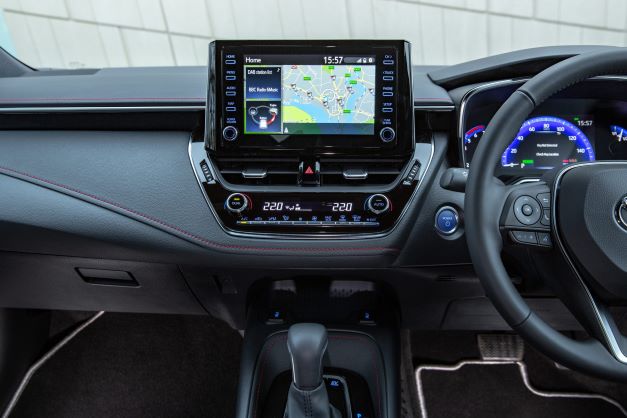
Active and passive safety systems
All versions of Corolla are equipped with Toyota Safety Sense, a suite of active safety technologies designed to help prevent or mitigate collisions. These include a pre-collision system, adaptive cruise control, lane departure alert, lane trace assist, automatic high beam and road sign assist
The chore of parking is eased thanks to a park assist system that uses a rear camera and sensors located around the sides and bumpers to identify viable reverse and parallel parking spaces.
In terms of passive safety features, Corolla’s body rigidity has been increased by around 60 per cent through the greater use of adhesives and spot welds.
Hot-stamped and ultra-high tensile steel are used to reinforce the front and centre pillars, the front door beltline, roof cross-members, the inner roof and front header extension, which helps suppress cabin deformation and optimise occupant protection.
A new ‘floating island’ bonnet inner structure helps reduce the inertia G forces at the start of a collision and combines with a cowl louvre impact-absorbing structure to mitigate head injuries in the event of a pedestrian impact.
All Corolla models are equipped with driver and front passenger front and side airbags, driver’s knee airbags and curtain shield airbags. The front seatbelts have a new-shape shoulder anchor which reduces the force needed to pull the belt. The belt’s locking sensitivity has been changed to make fastening smoother when the belt is pulled quickly. The adoption of a flexible inner belt allows for easier fastening, regardless of the buckle angle.
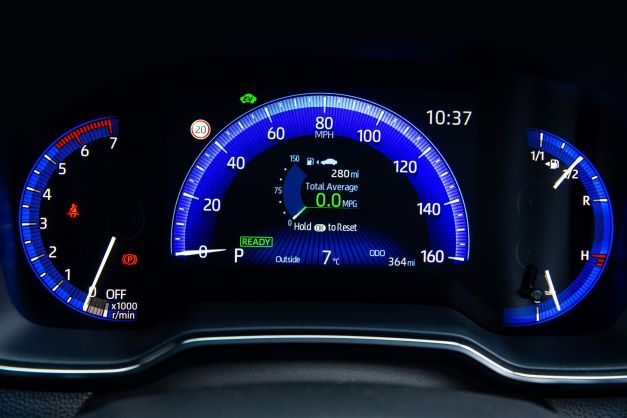
A change for the better
Toyota recently refreshed its Corolla and C-HR model ranges, introducing its Smart Connect+ multimedia system, new trims, colours and a special new version of the Corolla Trek Touring Sports.
The new connectivity platform has a more powerful processing capacity (CPU) that operates 2.4 times faster than the current system. Operated via an eight-inch High-Definition central touchscreen, it gives instant access to a series of smart connected services, including cloud-based navigation with continuous, “always-on” traffic information, 3D city mapping, highway signage and fixed traffic camera locations. The driver can also make use of a new onboard voice agent that recognises natural, conversational requests to operate the multimedia and navigation.
The Trek Special Edition cabin features piano black door handles, black leather upholstery and a satin chrome deco line across the instrument panel and front doors.
Six spec levels are offered, from the Icon, Icon Tech, Design, GR Sport, TREK to the top-drawer Excel. The uncluttered cockpit with polished black panels and touches of metal edging makes it a pleasant place to spend time behind the wheel. The sat-nav and infotainment are easy to use without becoming too distracting.
On balance, this renamed well-equipped model with some neat touches felt brisk, quiet and poised at every turn. It is also economical. Officially, the 2.0-litre petrol hybrid hatchback will achieve 50 mpg. Our run-about this week, mostly involving a gentle, steady cruise along motorways and dual carriageways, achieved a perfectly agreeable 47 mpg. Rival models include the VW Golf, Ford Focus and Skoda Octavia.
